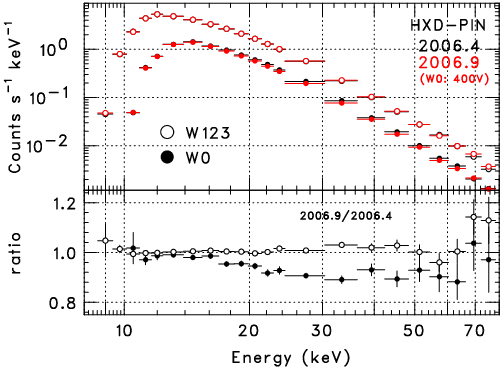HXD/PIN Response Files for W123/23
For Version 1.X Processed Data

In this comparison, filled circles (labeled "W0") indicate data from the 16 PIN diodes for which the bias voltage was changed, while open circles ("W123") denote data from the other 48 diodes. While the effective area stayed almost the same below 15 keV, it decreased about 10% above 20 keV which corresponds to a few percent decline of the "total" effective area of HXD/PIN.
On 2006 October 3, the bias voltage for 16 more diodes was changed from 500 to 400 V. After this date, HXD/PIN consists of 32 PIN diodes biased with 400 V, and the other 32 diodes biased with 500 V ("W23").
In the current PIN response matrices (2006 August 14 version), this effect is not yet taken into account. In addition, the level and shape of PIN non X-ray background (NXB) are also expected to be different between two bias voltages, as a consequence of the loss of effective area. Therefore, especially in case of the faint source observations, the "standard" PIN analysis, which treat all the 64 diodes with no distinction, might lead to an imcorrect conclusion.
The HXD team is in the process of calibrating the PIN performance at reduced bias voltage. In the mean time, the HXD team recommend the observers to exclude data from the "diodes with with 400 V bias," use the background event files for the same set of diodes, and use the corresponding modified response files.
The PIN event files contain a column called "UNITID," ranging in value from 0 to 15, corresponding to the 16 well-type phoswich units of the HXD, and there are 4 diodes per unit. "W123" corresponds to UNITID 4-15, while "W23" corresponds to UNITID 8-15. Therefore, the initial reduction in bias was for diodes in UNITID=0, 1, 2, 3. Therefore, events with "UNITID>3" should be selected for analysis for observations taken between 2006 May 24 and Oct 3. Similarly, for data taken afte 2006 Oct 3, events with "UNITID>7" should be selected. Then,
- Observations taken between 2006 May 24 and Oct 3:
- Select events with "UNITID>3" before extracting the spectrum.
- Obtain the appropriate NXB file
- Use ae_hxd_pinxinom_20060814_w123.rsp.gz (for observations at the XIS nominal pointing position) or ae_hxd_pinhinom_20060814_w123.rsp.gz (for observations at the HXD nominal pointing position).
- Observations taken after 2006 Oct 3:
- Select events with "UNITID>7" before extracting the spectrum.
- Obtain the appropriate NXB file
- Use ae_hxd_pinxinom_20060814_w23.rsp.gz (for observations at the XIS nominal pointing position) or ae_hxd_pinhinom_20060814_w23.rsp.gz (for observations at the HXD nominal pointing position).
If you have any questions concerning Suzaku, visit the Feedback form.

